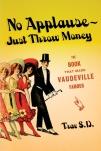A new kind of venue entered the competition for patronage during the later years of vaudeville. With the concert saloon virtually extinct since the turn of the century, and always ill-regarded, a niche opened up for a new sort of venue, the night club.
One of the protoypes for this new idea in the U.S., I think, has to be the roof garden. These combination restaurant/ performance venues, ensconced atop Broadway theatres, have their roots in an even older form, the beer garden, brought to the U.S. by German immigrants. In contrast with saloons, they were much more refined, and even family-oriented. Alcohol was consumed, but so was food, and the entertainment provided less inclined to be of a “low caliber”. In old New York, these were clustered in lower Manhattan, in the region around the Bowery.
In the late 19th century, as fabulous Broadway venues were being constructed full of amazing new amenities, one of the new innovations was an additional venue on the roof so that entertainments could take place after hours, or during the summer (because indoor theatres were usually closed during those months in the days before air conditioning). The kind of entertainment offered in roof gardens tended to be vaudeville shows and revues. Hammerstein’s short-lived Olympia (built 1895) was one of the first; his Victoria (built 1898) had one that proved to be more lasting. Other theatres that featured a roof garden included the New Amsterdam, where Ziegfeld presented his Midnight Frolics, the Casino (the first), the Republic, the Century, et al.
The other type of venue that fed into the genesis of the night club is the Parisian style cabaret. In 1911 Jesse Lasky built his own version of the Parisian Folies Bergère in Times Square, where the likes of Olga Petrova and Mae West found early employment. (The building, renamed the Helen Hayes Theatre, still stands today).
The dance craze started by the Castles (1912), the advent of jazz (1915) and then Prohibition (1919) added to the allure of this exciting resurrection of the old saloon idea. Harlem, Times Square and Greenwich Village all became club hubs. Jimmy Durante, Texas Guinan, and Helen Morgan are all more famous for the time they spent running speakeasy floor shows than for their time on the vaudeville stage. Many (probably most) of vaudeville’s singers, dancers and musicians, and some of the stand-up comedians and two-acts found lucrative work in these joints in the 20s, eventually making them less available to the formerly exclusive precincts of vaudeville.
In Manhattan, the swanky night club scene flourished until the 1940s or 50s, after which it was gradually supplanted by countless tiny cabarets.
In a related phenomenon, resort hotels booked live variety talent, before, during and after the vaudeville years. In the Catskill mountains, a constellation of large hotels and campgrounds catered to the vacationing needs of New York’s voluminous Jewish population. In the salad days of the so-called “Borscht Belt”, there were 500 hotels in the region, notably: Brown’s, the Concord, and Grossinger’s. In addition to the top headliners from the Palace like Milton Berle and Phil Silvers, a few years later you might see Henny Youngman, Jerry Lewis, Alan King, Danny Kaye, Joey Bishop, Red Buttons, or Jackie Gleason. All are performers but a single remove from vaudeville. Obviously, these venues were much more family-oriented than night club, food predominating over alcohol as the patrons’ chosen poison.
Outside of the Catskills, Miami, Atlantic City and Las Vegas have all been lucrative havens for the variety entertainer. An ossified form of vaudeville lives on in all of these sunset metropolises. As well as cruise ships! Don’t get me started on cruise ships! (Really, don’t. I have nothing to say about them!)
To learn more about the variety arts past and present, including night club and resort entertainment, consult No Applause, Just Throw Money: The Book That Made Vaudeville Famous, available at Amazon, Barnes and Noble, and wherever books are sold.


